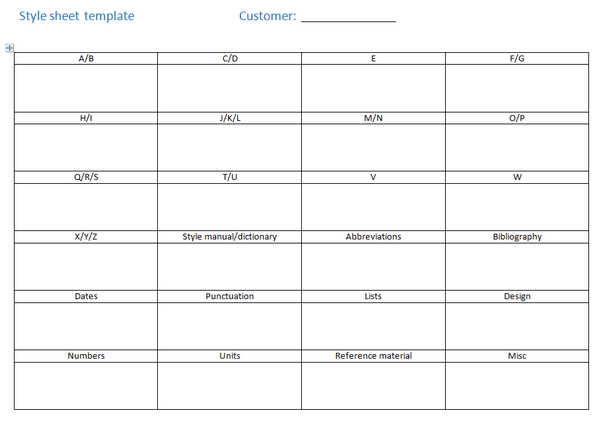The whys and hows of a style guide
This is the third part of Translation Quality 101 series.
- Part 1. Source materials for translation.
- Part 2. Terminology management.
- Part 4. Purchase order.
You may think that style guides describing language recommendations and stylistic nuances are for global companies and thriving publishing houses only. Want to think again?
Your translator will appreciate even a short and simple instruction especially if it is combined with a glossary and reference materials.
When the translator knows for sure what are the company’s preferred terms and style the task will be completed faster.
Please note that if carefully prepared and regularly updated, a style guide is a key to increasing the quality of translations and the effectiveness of published materials.
WHAT IS A STYLE GUIDE?
A style guide is a list of defined requirements—sometimes a very short one—that reflects the expectations and preferences of a translation customer.
To make your guide easier to use, consider a two-part structure. The first part could be regular and valid for all translation tasks, and the part second could be variable and project-related.
Feel free to include a brief description of your company, its products and services, main goals and tasks in the regular part. Other possible options are:
- Target market (country, industry, competitors)
- Language style: clear, academic, technical, etc.
- Forbidden words and terms
- Non-translated words and phrases
- Non-standard abbreviations
- Formatting and typography (fonts, phone numbers, etc.)
The changing part is valid for a current translation project only:
- Document type: a promo leaflet, press release, website update, etc.
- Target audience: age, social, occupation, etc.
- Aim of the document: branding and image, customer information (for sales team, for marketing team, etc.)
- Tone: formal, informal, neutral
- In focus: information or style; close proximity to the original or adaptation for better engagement.
WHY A STYLE GUIDE?
Expectations and preferences approved beforehand help maintain the consistent tone and language improving the company’s image.
When presented with a style guide, the translator needs less time for research and reference reading, so the material is delivered quicker. Moreover, knowing the target audience (an ideal reader or website visitor), your translator will be able to choose proper style and language.
No extra round of inner corrections and approvals means further time savings for the customer.
When developing a style guide, pay special attention to the document structure. Nobody is going to use a guide if it is too complex or overloaded with information (even with the words ‘DON’T PANIC’ in large, friendly letters on the cover). Leave out rules and recommendations that are well-known to any professional translator or a linguist. If the document has many pages, consider adding a table of content with links.
WHO CREATES A STYLE GUIDE?
Too often translation customers underestimate the importance of clear instructions and rules. But a proper style guide can be created only through their intensive engagement. The customer is providing reference materials, notes, and information. Clearly, it’s up to the customer to define the desired audience and the message.
McLean’s Maxim: There are only two problems with people. One is that they don’t think. The other is that they do. There will be always someone (an employee or a subcontractor) who tries to ignore the style guide no matter how clear and simple it is. To keep such cases to an absolute minimum, (a) update your style guide consistently; (b) make it easily accessible to all interested stakeholders.
If no style guide is available, the translator and the reviewer can create a version of their own. It could be as simple as that:
WHEN IS A STYLE GUIDE CREATED?
Data collection, style guide updates and edits should be handled by one person. For a light start, create a list of names, persons, titles, terms, abbreviations that are already present in the company’s documents. Common mistakes and translation-related questions can be added to the style guide later.
If you are a translator pondering over a style guide, the best time to create one is when you are starting your cooperation with a new customer. You can update the document when the customer sends you edits or comments explaining certain standards or undesirable terms.
Improvise! The introduction to the style guide by The Economist begins with six elementary rules formulated by George Orwell.
1 Never use a metaphor, simile or other figure of speech which you are used to seeing in print.
2 Never use a long word where a short one will do.
3 If it is possible to cut out a word, always cut it out.
4 Never use the Passive where you can use the active.
5 Never use a foreign phrase, a scientific word or a Jargon word if you can think of an everyday English equivalent.
6 Break any of these rules sooner than say anything outright barbarous.
SOME USEFUL LINKS
– BBC News Style Guide: https://www.bbc.co.uk/academy/en/collections/news-style-guide
– Microsoft Style Guides: https://docs.microsoft.com/en-us/style-guide/welcome
– Facebook Language Style Guide: https://www.facebook.com/translations/style_guides
– Apple Style Guide: https://help.apple.com/applestyleguide/
– A Guide on Style Guides https://www.writethedocs.org/guide/writing/style-guides/






